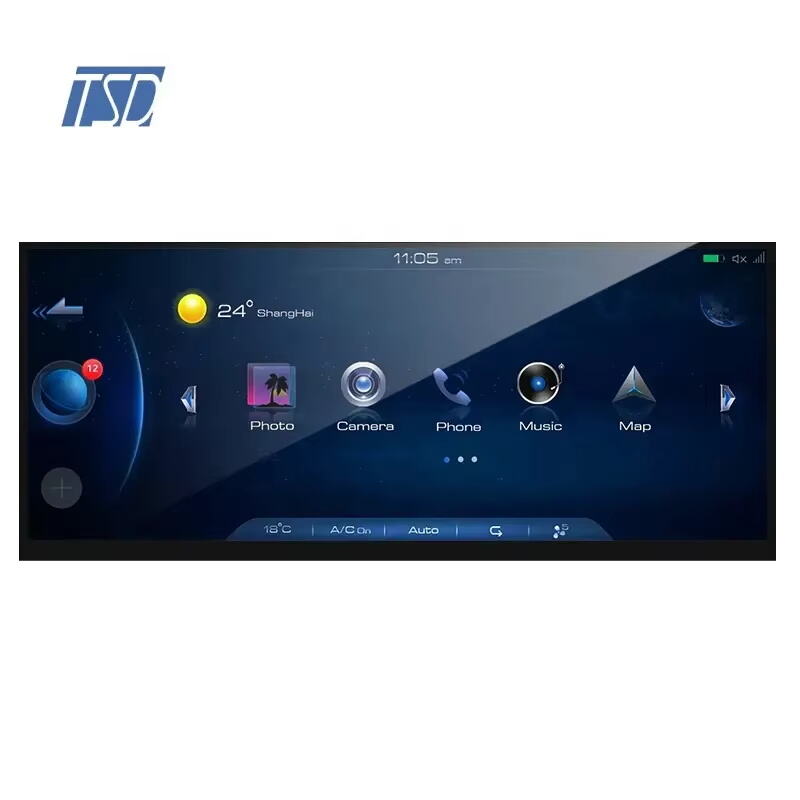Mga Hamon sa Tibay ng Automotive LCD sa Matinding Kapaligiran
Epekto ng Pagyanig sa Performance ng LCD
Ang mga vibrations sa kalsada ay talagang nakakaapekto sa haba ng buhay at pagganap ng automotive LCD screens. Ang mga sasakyan na kumikilos nang iba-iba depende sa surface ng kalsada ay nagdudulot ng problema sa mga display panel sa loob. Mayroon kaming data na nagpapakita ng mga sasakyan na nakakaranas ng iba't ibang antas ng vibration depende sa lugar na kanilang dinadaanan, at ito ay nakapagpapahina sa reliability ng LCD sa paglipas ng panahon. Lalo na kapag nagmamaneho sa mga bumpy road, maaaring mag-loose ang mga pixel o magsimulang mag-flicker ang screen nang nakakainis. Maraming drivers ang nagre-report ng pagkabigo kapag ang kanilang dash display ay nagsisimulang magka-problema dahil sa sobrang shaking habang nagmamaneho. Karamihan sa mga problemang ito ay bunga ng hindi magandang pagdidisenyo na hindi sapat na nakakaprotekta sa mga LCD unit sa pilit na vibrations sa kalsada. Iyon ang dahilan kung bakit kailangan ng mga manufacturer na maging mas maigting sa pagbuo ng mas matibay at mas matagalang LCD solutions para sa mga sasakyan kung nais nilang magkaroon ng nasisiyang mga customer.
Thermal Stress in Automotive Applications
Ang mga LCD screen ng kotse ay may malubhang problema sa init dahil ang mga sasakyan ay gumagana sa lahat ng uri ng matinding panahon. Ang paulit-ulit na pagbabago ng temperatura ay nagdudulot ng paglaki at pag-urong sa mahahalagang bahagi ng display, kabilang ang mga layer ng salamin at likidong kristal. Matapos maraming beses na mahapunan ng stress na ito, nagsisimula ang mga pagkabigo, na nagpapababa sa katiyakan ng mga automotive display na ito. Ang pagsubok ay nagpapakita na kapag ang mga LCD ay dumadaan sa parehong matinding init at lamig nang paulit-ulit, mas madalas silang nabigo kaysa karaniwan. Maaaring mabasag o tumigil sa tamang pagpapatakbo ang mga bahagi pagkatapos ilagay sa matagalang thermal stress, kaya kailangan ng mga inhinyero ng mas mahusay na paraan upang gawing mas matatag ang mga display na ito sa ganitong mga kondisyon. Mahalaga ang paglutas ng mga isyung ito kung nais nating ang mga LCD sa kotse ay mas matagal at gumana nang maayos sa anumang klima man ang nararanasan.
Mga Solusyon sa Pag-Inhenyeriya para sa Paggalaw
Mga Prinsipyo sa Disenyo ng Ruggedized na Display
Kailangan ng matibay na disenyo ang mga LCD screen sa kotse kung sila ay magtatagal sa libu-libong pag-uga ng kalsada nang hindi masisira. Maraming mga tagagawa ang nagtuon sa paggawa ng kanilang mga display na mas matibay sa pamamagitan ng paggamit ng mas mahusay na mga materyales at mga bagong teknolohikal na solusyon. Kabilang dito ang paggamit ng pinatibay na salaming panel at mga fleksibleng circuit board bilang karaniwang solusyon sa mga isyu ng mekanikal na stress. Talagang binabawasan ng mga komponente ito ang problema sa mga pixel at nagpapanatili na gumagana nang maayos ang screen sa paglipas ng panahon. Ayon sa datos mula sa industriya, kapag ang mga LCD ay ginawa gamit ang mga matibay na espesipikasyon, mas mataas ang kanilang pagganap sa tunay na mga kondisyon sa pagmamaneho. Hindi na gaanong naapektuhan ng mga pag-uga ang mga ito, kaya mataas ang kanilang katiyakan kahit sa mga kalsadang hindi maayos. Kung titingnan kung paano ginagamit ang mga sasakyan ngayon, makatuwiran kung bakit patuloy na pinapabuti ng mga tagagawa ang mga salik na ito ng tibay. Sa huli, walang gustong masira ang display ng kanilang dashboard habang nagmamaneho sa mga matatalbog na daan o masira habang nasa off-road.
Mga Advanced na Teknik sa Pag-mount para sa Shock Absorption
Ang mga paraan ng pag-mount ay kasinghalaga ng matigas na mga materyales pagdating sa pagprotekta sa mga LCD screen ng kotse mula sa mga pagkabigla. Ang mga modernong pamamaraan ay nagpapahintulot sa mga tagagawa na mai-install ang mga display na mas nakakatagal sa mga bump at magaspang na kalsada. Upang magsimula, ang mga passive mount tulad ng goma na mga gasket ay medyo epektibo para sa pangunahing proteksyon laban sa mga pag-iling dahil sila ay lumuluwis sa galaw. Pero may isa pang opsyon - ang mga aktibong sistema ng pag-mount na talagang umaangkop sa iba't ibang antas ng pag-iling. Ang mga matalinong sistema na ito ay binabago ang kanilang paglaban depende sa kalakasan ng mga pag-iling. Ang mga pagsusulit sa tunay na mundo ay nagpapakita na ang tamang pag-mount ay talagang nagpapaganda sa haba ng buhay ng mga screen bago kailanganin ang palitan. Ang mekanikal na stress ay nabawasan nang malaki, kaya ang pinsala ay nangyayari nang mas bihag. Kapag hinayaan ng mga inhinyero ang tamang solusyon sa pag-mount para sa bawat aplikasyon ng sasakyan, nagtatapos sila sa mas matibay at maaasahang mga sistema ng display sa lahat ng uri ng kotse at trak.
Mga Teknolohiya para sa Pag-angkop sa Malawak na Temperatura
Mga Inobasyon sa Materyales para sa Thermal Stability
Ang pagkakaalam kung paano nakakaapekto ang iba't ibang materyales sa thermal stability ay nagpapagkaiba sa pagpapahusay ng performance ng automotive LCD. Marami nang automotive manufacturers ang gumagamit ng mga bagay tulad ng polymer composites at special coatings para maprotektahan ang mga ito mula sa pinsala sa iba't ibang temperatura. Napakahalaga ng mga komponente dahil pinapanatili nila ang kalinawan ng mga screen kahit na may malaking pagbabago sa temperatura sa labas. Halimbawa, ang polymer composites ay talagang nakakapigil sa pag-crack na maaaring mangyari dahil sa biglang pagbabago ng temperatura. Ayon sa mga pag-aaral, makabuluhan ang epekto ng mga materyales na ito sa performance ng display habang pinapanatili pa rin ang kaliwanagan ng imahe. Ang mga drayber ay nakakatanggap ng mga screen na maaasahan kahit ito ay 110 degrees Fahrenheit sa tag-init o nasa ilalim ng zero sa taglamig. Ilan sa mga kumpanya ay nagsasabi na napapansin ng kanilang mga customer ang mas kaunting problema sa pagbabasa ng screen pagkatapos lumipat sa mga bagong solusyon sa materyales.
Dynamic Backlight Control Systems
Ang mga sistema ng kontrol sa backlight na dinamiko ang pagbabago sa paraan ng pagganap ng LCD sa iba't ibang temperatura. Kapag lumamig ang panahon o masyadong liwanag sa loob ng kotse, ang mga matalinong sistema ay nag-aayos ng kaliwanagan ng screen upang manatiling malinaw at mabasa ang display. Ang mga benepisyo ay lampas pa sa mas mahusay na visibility. Ang mga sasakyan na may ganitong teknolohiya ay talagang gumagamit ng mas kaunting kuryente dahil ang sistema ay gumagamit lamang ng kailangang-kailangan para sa kasalukuyang kondisyon. Nagpapakita ang mga pagsubok na ang mga screen ay mas matagal ang buhay kapag ginagamit ang dynamic na paraan ng pag-aayos, na isang mahalagang aspeto para sa mga tagagawa ng sasakyan na naghahanap ng pagtatayo ng mga maaasahang produkto. Nagsimula nang isama ng mga tagagawa ng kotse ang mga advanced na tampok na ito sa kanilang mga dashboard at sistema ng impormasyon at aliwan, upang maipadala ang kalidad ng visual habang pinapanatili ang mababang pagkonsumo ng gasolina na talagang pinahahalagahan ng mga environmentally-conscious na mamimili.

Mga Pamantayan sa Pagsubok para sa Automotive-Grade na LCDs
Mga Protocolo sa Sertipikasyon ng Resistance sa Vibration
Upang mapabuti ang haba ng buhay ng automotive LCD, kinakailangan ang tamang sertipikasyon para sa paglaban sa pagyanig. Ang mga sertipikasyong ito ay nagsasaad kung ang LCD screen ay kayang tumanggap ng mga kondisyon sa loob ng kotse sa paglipas ng panahon. Ang mga pagsubok ay nagsusuri kung gaano kahusay ang paglaban ng mga screen sa pagbugso at pagpapanatili ng pagpapatakbo nito sa kabila ng paulit-ulit na pagyanig mula sa kalsada at paggalaw ng makina. Ang mga kilalang organisasyon tulad ng ISO at SAE ang gumagawa ng karamihan sa mga pamantayang ito, at kinakailangan para sa mga tagagawa ng bahagi ng kotse na sumunod sa mga ito upang mapatunayan ang kanilang produkto. Isa sa halimbawa ay ang ISO 16750-3 na naglalatag nang eksakto kung paano subukan ang mga elektrikal na bahagi upang matiyak na hindi ito mabibigo kapag nalantad sa pangkaraniwang pagyanig ng sasakyan araw-araw. Ang mga screen na nakakaraan sa mahigpit na pagsubok na ito ay napupunta sa mga lugar kung saan mahalaga ang pagkakatiwalaan, isipin ang mga GPS unit o digital na dashboard. Ang tunay na halaga? Ang mga sertipikadong display ay nagbibigay ng kapayapaan ng isip dahil alam na patuloy itong gagana nang maayos kahit ilagay sa iba't ibang uri ng matinding pagtrato habang nasa normal na pagmamaneho.
Mga Paraan ng Pagpapatunay sa Temperature Cycling
Mahalaga ang pag-unawa sa mga paraan ng pagpapatunay ng pagbabago ng temperatura kapag sinusuri kung gaano katagal ang paggamit at pagiging epektibo ng LCD ng kotse. Kadalasang ginagawa ng mga tagagawa ay ilalagay ang mga screen na ito sa sobrang init at lamig na mga kondisyon na katulad ng nararanasan nila sa loob ng kotse sa iba't ibang panahon. Ang mismong proseso ng pagsubok ay kinabibilangan ng paulit-ulit na pag-init at paglamig ng display upang masuri kung paano nila kayanin ang mga tensyon mula sa paglaki at pag-urong. Para makaraan ang isang LCD sa ganitong pagsubok, dapat manatiling malinaw at gumagana ito kahit matapos ang daan-daang beses nang pagbabago na ito, nang hindi nagpapakita ng bitak o anumang pinsala. Ang mga bagong pagbabago sa mga pamantayan ng industriya ay nagtulak para sa mas mahusay na disenyo na kayanang-kayanan ang pagbabago ng temperatura. Nakitaan din natin ng tunay na pagpapabuti mula sa paraang ito ng pagsubok - tulad ng mas matibay na protektibong patong at muling idisenyong panloob na mga bahagi. Ang mga pag-unlad na ito ay nangangahulugan na mas matibay ang mga display ngayon kaysa dati, at kayanang-kayanan ang lahat mula sa init ng disyerto hanggang sa malamig na taglamig sa Arctic nang hindi nasira.
FAQ
Ano ang mga pangunahing hamon na kinakaharap ng automotive LCDs?
Madalas na kinakaharap ng automotive LCDs ang mga hamon tulad ng pag-vibrate mula sa kondisyon ng kalsada at thermal stress dahil sa sobrang init o lamig, na nakakaapekto sa pagganap at tibay nito.
Paano nakakaapekto ang pag-vibrate sa automotive LCDs?
Ang pag-vibrate ay maaaring magdulot ng pagkabigo ng pixel, pagngitiw ng screen, at posibleng pagkasira ng display dahil sa mechanical stress.
Bakit isang problema ang thermal stress para sa automotive LCDs?
Ang thermal stress ay maaaring magdulot na ang mga bahagi ng LCD ay lumaki o umurong, na nagreresulta sa posibleng pagkabigo at nabawasan ang reliability sa paglipas ng panahon.
Anu-anong solusyon sa engineering ang available upang mapalakas ang tibay ng LCD?
Kasama sa mga solusyon ang ruggedized display designs, advanced mounting techniques para sa shock absorption, at inobasyon sa materyales para sa mas mahusay na thermal stability.
Paano nakatutulong ang dynamic backlight control systems sa automotive LCDs?
Ang mga sistemang ito ay nag-o-optimize ng visibility at kahusayan sa enerhiya sa pamamagitan ng pagsasaayos ng liwanag ng ilaw sa likod ayon sa kondisyon ng paligid.
Anu-ano ang inaasahang uso sa teknolohiya ng automotive display sa hinaharap?
Kasama sa mga darating na uso ang integrasyon ng MicroLED advancements at smart thermal management systems upang mapahusay ang performance at kahusayan.
Talaan ng Nilalaman
- Mga Hamon sa Tibay ng Automotive LCD sa Matinding Kapaligiran
- Mga Solusyon sa Pag-Inhenyeriya para sa Paggalaw
- Mga Teknolohiya para sa Pag-angkop sa Malawak na Temperatura
- Mga Pamantayan sa Pagsubok para sa Automotive-Grade na LCDs
-
FAQ
- Ano ang mga pangunahing hamon na kinakaharap ng automotive LCDs?
- Paano nakakaapekto ang pag-vibrate sa automotive LCDs?
- Bakit isang problema ang thermal stress para sa automotive LCDs?
- Anu-anong solusyon sa engineering ang available upang mapalakas ang tibay ng LCD?
- Paano nakatutulong ang dynamic backlight control systems sa automotive LCDs?
- Anu-ano ang inaasahang uso sa teknolohiya ng automotive display sa hinaharap?




